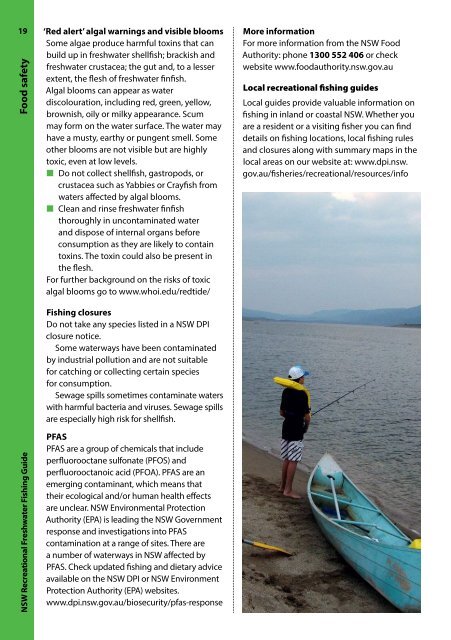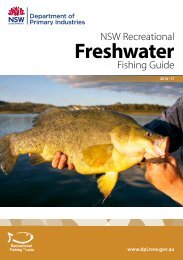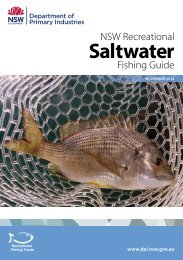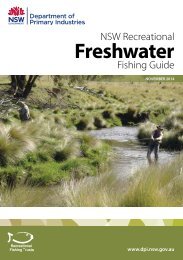freshwater-recreational-fishing-guide-2018-19
Create successful ePaper yourself
Turn your PDF publications into a flip-book with our unique Google optimized e-Paper software.
<strong>19</strong><br />
Food safety<br />
‘Red alert’ algal warnings and visible blooms<br />
Some algae produce harmful toxins that can<br />
build up in <strong>freshwater</strong> shellfish; brackish and<br />
<strong>freshwater</strong> crustacea; the gut and, to a lesser<br />
extent, the flesh of <strong>freshwater</strong> finfish.<br />
Algal blooms can appear as water<br />
discolouration, including red, green, yellow,<br />
brownish, oily or milky appearance. Scum<br />
may form on the water surface. The water may<br />
have a musty, earthy or pungent smell. Some<br />
other blooms are not visible but are highly<br />
toxic, even at low levels.<br />
■■<br />
Do not collect shellfish, gastropods, or<br />
crustacea such as Yabbies or Crayfish from<br />
waters affected by algal blooms.<br />
■■<br />
Clean and rinse <strong>freshwater</strong> finfish<br />
thoroughly in uncontaminated water<br />
and dispose of internal organs before<br />
consumption as they are likely to contain<br />
toxins. The toxin could also be present in<br />
the flesh.<br />
For further background on the risks of toxic<br />
algal blooms go to www.whoi.edu/redtide/<br />
Fishing closures<br />
Do not take any species listed in a NSW DPI<br />
closure notice.<br />
Some waterways have been contaminated<br />
by industrial pollution and are not suitable<br />
for catching or collecting certain species<br />
for consumption.<br />
Sewage spills sometimes contaminate waters<br />
with harmful bacteria and viruses. Sewage spills<br />
are especially high risk for shellfish.<br />
More information<br />
For more information from the NSW Food<br />
Authority: phone 1300 552 406 or check<br />
website www.foodauthority.nsw.gov.au<br />
Local <strong>recreational</strong> <strong>fishing</strong> <strong>guide</strong>s<br />
Local <strong>guide</strong>s provide valuable information on<br />
<strong>fishing</strong> in inland or coastal NSW. Whether you<br />
are a resident or a visiting fisher you can find<br />
details on <strong>fishing</strong> locations, local <strong>fishing</strong> rules<br />
and closures along with summary maps in the<br />
local areas on our website at: www.dpi.nsw.<br />
gov.au/fisheries/<strong>recreational</strong>/resources/info<br />
NSW Recreational Freshwater Fishing Guide<br />
PFAS<br />
PFAS are a group of chemicals that include<br />
perfluorooctane sulfonate (PFOS) and<br />
perfluorooctanoic acid (PFOA). PFAS are an<br />
emerging contaminant, which means that<br />
their ecological and/or human health effects<br />
are unclear. NSW Environmental Protection<br />
Authority (EPA) is leading the NSW Government<br />
response and investigations into PFAS<br />
contamination at a range of sites. There are<br />
a number of waterways in NSW affected by<br />
PFAS. Check updated <strong>fishing</strong> and dietary advice<br />
available on the NSW DPI or NSW Environment<br />
Protection Authority (EPA) websites.<br />
www.dpi.nsw.gov.au/biosecurity/pfas-response








